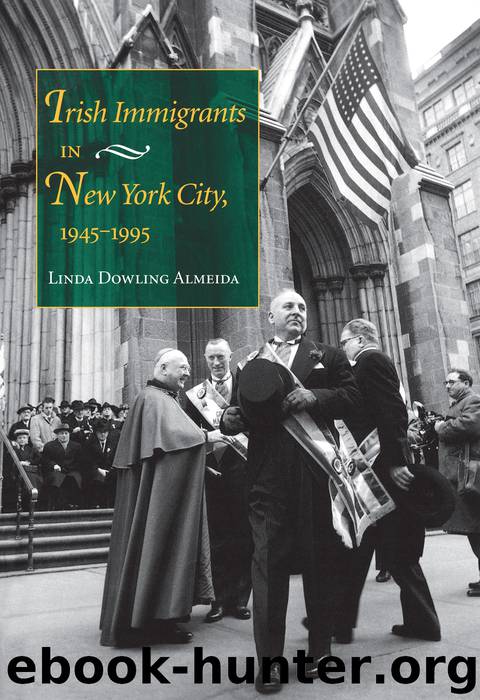Irish Immigrants in New York City, 1945-1995 by Almeida Linda Dowling;

Author:Almeida, Linda Dowling;
Language: eng
Format: epub
Publisher: Indiana University Press
Published: 2017-02-21T16:00:00+00:00
6
Who Are the Irish?
Irish Americans are no more Irish than black Americans are
Africans.
—Bob Geldof, musician, quoted in Irish Echo, 19871
What defines the Irish? What is an Irish American? What is the difference between the two? Since the nineteenth century, any given generation of the community in New York included immigrants as well as first-, second-, and third-generation Irish and Irish Americans. And within that population were immigrants who had left the homeland at different points in Ireland’s development and for vastly different reasons.
Examples of the layers within the ethnic population exist throughout history and have been recognized by novelists and historians alike. Peter Quinn made it quite clear in Banished Children of Eve that the American-born children of Irish immigrants considered themselves separate from their Irish-born peers. The two groups fought each other for control of the neighborhood streets of Civil War New York.2 Eric Foner made distinctions in class and motivation for the immigrant and American ethnic support that the United States Irish community gave to the Fenians and home rule in the 1870s and 1880s.3 And writing about the early twentieth century, Marion Casey observed that the image of what was Irish in America was so far removed from what Irish-born Irish understood that by the 1920s Irish “culture” in the United States existed on two levels: a popular culture driven by stereotypes formed over several generations of immigration, and a subculture fed by a Gaelic nationalism originating in Ireland and invigorated by the immigrant refugees of the Irish Civil War.
What is fascinating to the observer of these different communities is that often to the outside world the “Irish” community appeared to be homogeneous. And at any given moment in time the general population had a specific, singular image of the Irish that did not reflect the diversity within the ethnic population. The conflicts within the Irish community typically occurred between new immigrants and the Irish establishment into which they entered. In the case of the post–World War II migrants to New York, this kind of misconception involved the Irish American community led by migrants of the 1950s and their reception of the New Irish in the 1980s. By 1980 the ethnic community in New York was composed primarily of immigrant and first- and second-generation Americans whose image of Ireland was shaped in the years before 1960. The urban, educated, and arguably arrogant Irish youth who entered the United States in the 1980s clashed with the older generation’s image of the Irish. In the forty years following the first post–World War II wave of immigration to America, Ireland had changed radically, producing a different citizen and therefore a different migrant than the American Irish could recognize as one of their own. The older migrants’ years spent in America and the romance of memory ran parallel with very real changes in the society, economy, and culture of Ireland, producing two very different populations whose only commonality was an ethnic heritage and the migration experience.
Historically Irish identity has been linked
Download
This site does not store any files on its server. We only index and link to content provided by other sites. Please contact the content providers to delete copyright contents if any and email us, we'll remove relevant links or contents immediately.
| African-American Studies | Asian American Studies |
| Disabled | Ethnic Studies |
| Hispanic American Studies | LGBT |
| Minority Studies | Native American Studies |
Cecilia; Or, Memoirs of an Heiress — Volume 1 by Fanny Burney(32062)
Cecilia; Or, Memoirs of an Heiress — Volume 3 by Fanny Burney(31458)
Cecilia; Or, Memoirs of an Heiress — Volume 2 by Fanny Burney(31409)
The Great Music City by Andrea Baker(30781)
We're Going to Need More Wine by Gabrielle Union(18633)
All the Missing Girls by Megan Miranda(14737)
Pimp by Iceberg Slim(13779)
Bombshells: Glamour Girls of a Lifetime by Sullivan Steve(13685)
Fifty Shades Freed by E L James(12916)
Talking to Strangers by Malcolm Gladwell(12875)
Norse Mythology by Gaiman Neil(12828)
For the Love of Europe by Rick Steves(11477)
Crazy Rich Asians by Kevin Kwan(8888)
Mindhunter: Inside the FBI's Elite Serial Crime Unit by John E. Douglas & Mark Olshaker(8702)
The Lost Art of Listening by Michael P. Nichols(7160)
Enlightenment Now: The Case for Reason, Science, Humanism, and Progress by Steven Pinker(6875)
The Four Agreements by Don Miguel Ruiz(6319)
Bad Blood by John Carreyrou(6278)
Weapons of Math Destruction by Cathy O'Neil(5832)
